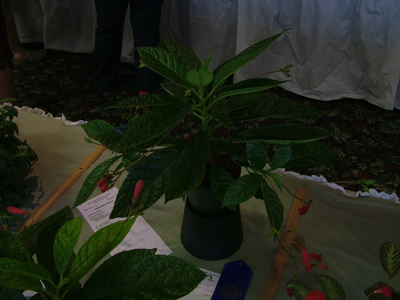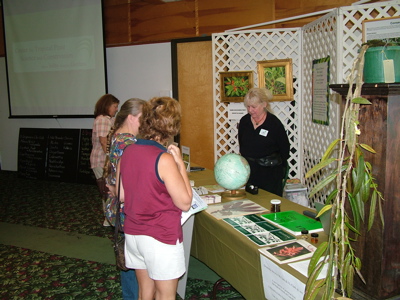By John R. Clark
Fellow gesneriad enthusiasts! We are finally here - the Gesneriad Research Center is open for research...at Selby Gardens. Not even two weeks in and we have several projects off the ground: we are moving forward with research, gesneriad promotion, an upcoming regional show and sale, and more. Let me take a few moments to tell you about some of these exciting developments.
Gesneriad Show and Sale. First off, Selby Gardens will be the site of the upcoming gesneriad show, "The ABC's of Gesneriads", co-hosted by the Tampa Bay and Suncoast Chapters of The Gesneriad Society. The show is this coming September 20-21 in Selby's Great Room by the Bay. The event promises to be a fantastic one with entries arriving from all over Florida along with several guest judges visiting from out of town. We are all excited to have a large contingent of gesneriad folks here at Selby for this event. For more information, check out Selby's upcoming events list at www.selby.org
Promoting gesneriads. One of the principal goals of the GRC is to promote gesneriads at Selby Gardens and elsewhere. To this end, we are working with Debbie Steele, Selby Gardens Public Relations Director, to design and publish a brochure featuring the GRC. Similarly, Donna Krabill, Director of Education at Selby (and a member of The Gesneriad Society!) is collaborating with Selby Research to design an education cart that will feature gesneriad and other research at Selby. This cart will be positioned out in the Gardens and staffed by knowledgeable volunteers. More on these efforts in the coming weeks!
Research updates:
New species of Drymonia. I, in collaboration with the other John Clark (John L. at the University of Alabama), have recently submitted papers describing two new species of Drymonia. These species, one from Costa Rica and the other from Ecuador, exhibit the variety of characters and form that can be found in this interesting genus.

Drymonia sp. nov. is characterized by dense clusters of flowers with bright orange, pouched corollas. The other Drymonia sp. nov. has more or less typical Drymonia flowers but is unique in having a graceful, pendulous habit.
Hawaiian Cyrtandra. In collaboration with Warren L. Wagner and Eric H. Roalson, I am working to complete a Monograph of Hawaiian Cyrtandra. Hawaiian species of Cyrtandra are quite diverse and have been historically difficult to classify. This monograph is the result of years of effort and will be a major milestone towards understanding this genus. As part of this work, Dr. Doug Rist, a retired surgeon, has begun volunteering at Selby for the GRC. Doug's job is to glean distribution data from an existing database on Hawaiian Cyrtandra specimens and use this information to construct detailed distribution data for the monograph. This painstaking process will be vital to making the monograph a valuable reference for years to come. On behalf of the GRC, I'd like to welcome Doug on board! I'd also like to welcome him to The Gesneriad Society - Doug's now a member!

Also related to this, Melissa McDowell (long-time Society member and Selby volunteer) is now working to compile a comprehensive file of Cyrtandra publications. Having a consolidated library of Cyrtandra literature will be indispensable as we continue the daunting task of understanding the diversity of this large genus (the largest in the Gesneriaceae). Since there are over 600 recognized species of Cyrtandra, and more than twice that number of named species, this new project is going to keep Melissa busy for quite some time. Thanks, Melissa!
(Above, a picture of a Cyrtandra richii from Samoa)
Believe it or not, there is actually more to tell, but I will save that for an upcoming installment. Check back soon for more updates, highlights from next week's gesneriad show and more!
 By John R. Clark
By John R. Clark
 By John R. Clark
By John R. Clark


 By John R. Clark and Bruce K. Holst
By John R. Clark and Bruce K. Holst